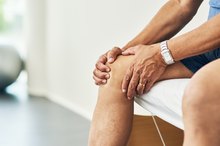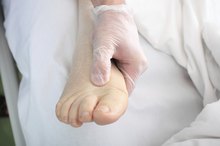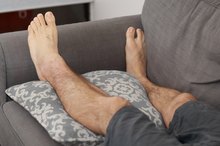How to Relieve Ankle Swelling Naturally
Swelling of the ankles occurs when excess fluid gets trapped in the tissues of the lower legs. Also referred to as edema, this swelling can be triggered by hot weather, prolonged standing or sitting, an ankle injury, or may be a side effect of late pregnancy.
If you are experiencing serious medical symptoms, seek emergency treatment immediately.
Foot and ankle swelling can also be related to heart, liver or kidney disease, medication side effects, blood clots, or lymphedema — a buildup of lymph, a colorless body fluid. While understanding and treating the underlying cause is an essential first step, there are several ways you can alleviate this ankle swelling at home.
Understand the Cause
If swelling is a new or sudden symptom, or if the edema is related to an injury, see your doctor for a diagnosis and a management plan 1. If your doctor has already assessed your ankle swelling, but your symptoms worsen, or if the edema is accompanied by shortness of breath, skin breakage or pain, seek urgent medical attention.
Treat the Underlying Cause
How to Reduce Swollen Legs & Feet
Learn More
To manage fluid retention, the underlying cause needs to be treated. So if your swelling is related to a sprain, rest and elevate your foot, wrap the ankle, and apply ice for 15 to 20 minutes every 2 to 4 hours. If you suspect your swelling is due to a medication side effect, let your doctor know as soon as possible.
Also, if you have an underlying condition that causes edema, such as kidney, heart or liver disease, follow your doctor's treatment advice on how to manage this condition and the related swelling. Depending on your situation, your doctor may recommend a dietary sodium restriction, a limitation of fluid intake, or a prescription diuretic, which helps flush extra fluid out of your tissues.
Elevate Your Feet
Spending time every day to elevate your feet is a helpful way to counter foot, leg and ankle swelling. This works best if your legs are above heart level for 30 minutes, several times daily. If you have mild swelling, elevation and dietary changes may be your most effective treatments. However, more severe swelling may require medication therapy.
Wear Support Stockings
How to Get Rid of Water Retention Fast
Learn More
Support stockings, also referred to as compression socks, apply pressure to the leg and ankle area and prevent extra fluid from getting trapped in the tissues.
Before using these as a home treatment, speak with your doctor to understand if compression therapy is appropriate to treat the underlying cause of your swelling. Also, since compression socks are rated with different pressure levels, your doctor can either prescribe the right socks for you, or guide you on the correct type to purchase from a drug or medical supply store.
Move More
Prolonged standing or sitting can increase the risk of swelling, particularly in people who already have a condition that leads to edema. If able, add exercise to your daily routine.
If you have to stand or sit for long periods of time, take breaks to walk around in order to improve circulation of blood and body fluids. Since movement and massage improves local circulation, it also helps to rotate and massage your swollen ankle — if you can do so comfortably without causing pain.
Tips
If your edema is related to venous insufficiency, which is impaired blood flow from the feet back to the heart, the swelling can be aggravated by hot temperatures. On hot days, aim to keep cool and elevate your legs to minimize foot, ankle and leg swelling.
Warning
In general, mild swelling does not require urgent medical evaluation, but any swelling should be discussed with your doctor. If you suspect an injury or a medication is the cause, or if you have a history of a heart, kidney or liver disorder and your edema worsens, see your doctor.
Seek urgent medical attention if your swelling is sudden onset, or if your swelling is accompanied by pain, shortness of breath, difficulty breathing, chest pain, or if you have leg or ankle swelling and tenderness on one side only.
Reviewed by Kay Peck, MPH RD
- In general, mild swelling does not require urgent medical evaluation, but any swelling should be discussed with your doctor.
- Seek urgent medical attention if your swelling is sudden onset, or if your swelling is accompanied by pain, shortness of breath, difficulty breathing, chest pain, or if you have leg or ankle swelling and tenderness on one side only.
Related Articles
References
Resources
Writer Bio
Catherine Smith has been writing professionally since 2000. She runs a client-based wellness office in Bastrop, Texas. She specializes in pain and stress management using herbs and alternative medicine She received her doctorate in natural health with a concentration in herbal studies from Clayton College of Natural Health.








